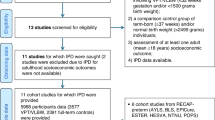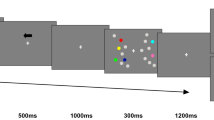Abstract
Background
This paper examines the visuospatial working memory (WM) performance of children and adults born very preterm (VPT) and/or very low birth weight (VLBW) relative to their full-term (FT)-born peers. Of interest was the nature and severity of observed impairments, as well associations with educational/occupational functioning at each age point.
Methods
Participants were drawn from two prospective cohort studies: (1) a regional cohort of 110 VPT (<32 weeks’ gestation and <1500 g) and 113 FT born children assessed at age 12 years; (2) a national cohort of 229 VLBW (<1500 g) and 100 FT born adults assessed at age 28 years. Visuospatial WM was assessed using a four-span/difficulty-level computerized task.
Results
Both children and adults born VPT/VLBW had poorer visuospatial WM than FT controls, with their performance less accurate, slower (correct trials), and less efficient with increasing task difficulty (Cohen’s d = 0.27–0.51; p < 0.05). Adults had better visuospatial WM than children, but between-group differences were highly similar across ages, before and after adjustment for confounding social background and individual factors. Poorer WM was associated with lower levels of educational and occupational/socioeconomic achievement.
Conclusions
Visuospatial WM difficulties persist into adulthood raising concerns for the longer-term cognitive and adaptive functioning of VPT survivors.
Impact
-
Both children and adults born very preterm have poorer visuospatial working memory than their term-born peers. They are less accurate, take longer to respond correctly and are less efficient, with test performance declining with increasing cognitive demand.
-
Similar differences in visuospatial working memory are observed between VPT/VLBW and full-term individuals during both childhood and adulthood, with these differences remaining even after covariate adjustment.
-
Individuals with poorer visuospatial working memory have lower levels of educational achievement and occupational/socioeconomic success.
-
Visuospatial working memory difficulties persist into adulthood and appear to continue to impact everyday functioning and life-course opportunities.
Similar content being viewed by others
Log in or create a free account to read this content
Gain free access to this article, as well as selected content from this journal and more on nature.com
or
References
Brydges, C. R. et al. Cognitive outcomes in children and adolescents born very preterm: a meta-analysis. Dev. Med. Child Neurol. 60, 452–468 (2018).
van Houdt, C. A., Oosterlaan, J., van Wassenaer-Leemhuis, A. G., van Kaam, A. H. & Aarnoudse-Moens, C. S. Executive function deficits in children born preterm or at low birthweight: a meta-analysis. Dev. Med. Child Neurol. 9, 1015–1024 (2019).
Aarnoudse-Moens, C. S., Smidts, D. P., Oosterlaan, J., Duivenvoorden, H. J. & Weisglas-Kuperus, N. Executive function in very preterm children at early school age. J. Abnorm. Child Psychol. 37, 981–993 (2009).
Woodward, L. J., Edgin, J. O., Thompson, D. & Inder, T. E. Object working memory deficits predicted by early brain injury and development in the preterm infant. Brain 128, 2578–2587 (2005).
Fitzpatrick, A., Carter, J. & Quigley, M. A. Association of gestational age with verbal ability and spatial working memory at age 11. Pediatrics 138, e20160578 (2016).
Clark, C. A., Pritchard, V. E. & Woodward, L. J. Preschool executive functioning abilities predict early mathematics achievement. Dev. Psychol. 46, 1176–1191 (2010).
Simms, V. et al. Nature and origins of mathematics difficulties in very preterm children: a different etiology than developmental dyscalculia. Pediatr. Res. 77, 389–395 (2015).
Clark, C. A. & Woodward, L. J. Neonatal cerebral abnormalities and later verbal and visuospatial working memory abilities of children born very preterm. Dev. Neuropsychol. 35, 622–642 (2010).
Moffitt, T. E. et al. A gradient of childhood self-control predicts health, wealth, and public safety. Proc. Natl Acad. Sci. USA 108, 2693–2698 (2011).
Dodgeon, B., Patalay, P., Ploubidis, G. B. & Wiggins, R. D. Exploring the role of early-life circumstances, abilities and achievements on well-being at age 50 years: evidence from the 1958 British birth cohort study. BMJ Open 10, e031416 (2020).
Luu, T. M., Ment, L., Allan, W., Schneider, K. & Vohr, B. R. Executive and memory function in adolescents born very preterm. Pediatrics 127, e639–e646 (2011).
Lundequist, A., Bohm, B., Lagercrantz, H., Forssberg, H. & Smedler, A. C. Cognitive outcome varies in adolescents born preterm, depending on gestational age, intrauterine growth and neonatal complications. Acta Paediatr. 104, 292–299 (2015).
Schneider, L. A. et al. Cognitive abilities in preterm and term-born adolescents. J. Pediatr. 165, 170–177 (2014).
Aanes, S., Bjuland, K. J., Skranes, J. & Lohaugen, G. C. Memory function and hippocampal volumes in preterm born very-low-birth-weight (VLBW) young adults. Neuroimage 105, 76–83 (2015).
Suikkanen, J. et al. Reaction times, learning, and executive functioning in adults born preterm. Pediatr. Res. 89, 198–204 (2021).
Pyhälä, R. et al. Self-reported mental health problems among adults born preterm: a meta-analysis. Pediatrics 139, e20162690 (2017).
Woodward, L. J. et al. Very preterm children show impairments across multiple neurodevelopmental domains by age 4 years. Arch. Dis. Child Fetal Neonatal Ed. 94, F339–F344 (2009).
Darlow, B. A. et al. The New Zealand 1986 very low birth weight cohort as young adults: mapping the road ahead. BMC Pediatr. 15, 90 (2015).
Pascoe, M. J., Melzer, T. R., Horwood, L. J., Woodward, L. J. & Darlow, B. A. Altered grey matter volume, perfusion and white matter integrity in very low birthweight adults. Neuroimage Clin. 22, 101780 (2019).
Sternberg, S. High-speed scanning in human memory. Science 153, 652–654 (1966).
Sternberg, S. In defence of high-speed memory scanning. Q. J. Exp. Psychol. 69, 2020–2075 (2016).
Milne, B. J., Byun, U. & Lee, A. New Zealand Socio-Economic Index (Statistics New Zealand, 2006).
Lean, R. E., Melzer, T. R., Bora, S., Watts, R. & Woodward, L. J. Attention and regional gray matter development in very preterm children at age 12 years. J. Int Neuropsychol. Soc. 23, 539–550 (2017).
Stalnacke, J., Lundequist, A., Bohm, B., Forssberg, H. & Smedler, A. C. A longitudinal model of executive function development from birth through adolescence in children born very or extremely preterm. Child Neuropsychol. 25, 318–335 (2019).
Burnett, A. C. et al. Executive function in adolescents born <1000 g or <28 weeks: a prospective cohort study. Pediatrics 135, e826–e834 (2015).
Mangin, K. S., Horwood, L. J. & Woodward, L. J. Cognitive development trajectories of very preterm and typically developing children. Child Dev. 88, 282–298 (2017).
Darlow, B. A., Woodward, L. J., Levin, K. J., Melzer, T. & Horwood, L. J. Perinatal and childhood predictors of general cognitive outcome at 28 years in a very-low-birthweight national cohort. Dev. Med. Child Neurol. 62, 1423–1428 (2020).
Nosarti, C. & Froudist-Walsh, S. Alterations in development of hippocampal and cortical memory mechanisms following very preterm birth. Dev. Med. Child Neurol. 58(Suppl. 4), 35–45 (2016).
Cheong, J. L. Y. et al. Changing neurodevelopment at 8 years in children born extremely preterm since the 1990s. Pediatrics 139, e20164086 (2017).
Stoll, B. J. et al. Trends in care practices, morbidity, and mortality of extremely preterm neonates, 1993-2012. JAMA 314, 1039–1051 (2015).
Funding
This work was supported by grants from the Health Research Council of New Zealand (11-283; 12-129) and Cure Kids (CHRF 5040; CHRF 5041) to B.A.D., L.J.H., and L.J.W., and a Mater Foundation Principal Research Fellowship to S.B. The funding sources had no role in the writing of the manuscript or in the decision to submit it for publication. The authors have no financial relationships relevant to this work to disclose.
Author information
Authors and Affiliations
Contributions
Substantial contributions to conception and design: B.A.D., L.J.H., and L.J.W.; acquisition of data: L.J.H. and B.A.D.; analysis: L.J.H. and S.B.; interpretation of data: all authors). Drafting the article or revising it critically for important intellectual content: L.J.W. with L.J.H., B.A.D., and S.B. Final approval of the version to be published: all authors.
Corresponding author
Ethics declarations
Competing interests
The authors declare no competing interests.
Additional information
Publisher’s note Springer Nature remains neutral with regard to jurisdictional claims in published maps and institutional affiliations.
Rights and permissions
About this article
Cite this article
Woodward, L.J., Horwood, L.J., Darlow, B.A. et al. Visuospatial working memory of children and adults born very preterm and/or very low birth weight. Pediatr Res 91, 1436–1444 (2022). https://doi.org/10.1038/s41390-021-01869-w
Received:
Revised:
Accepted:
Published:
Issue date:
DOI: https://doi.org/10.1038/s41390-021-01869-w
This article is cited by
-
Novel metrics to characterize temporal lobe of very preterm infants on term-equivalent brain MRI
Pediatric Research (2023)
-
Advocacy for research starting early in the life course
Pediatric Research (2022)



